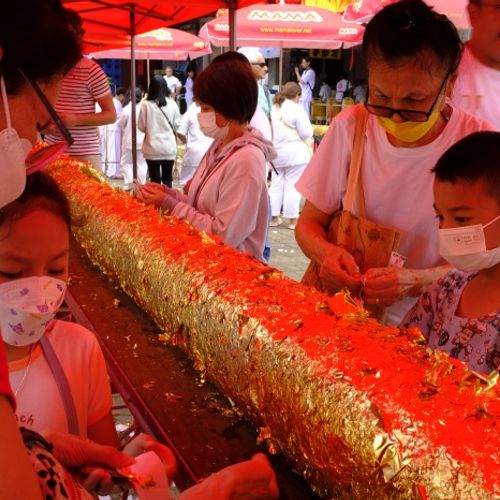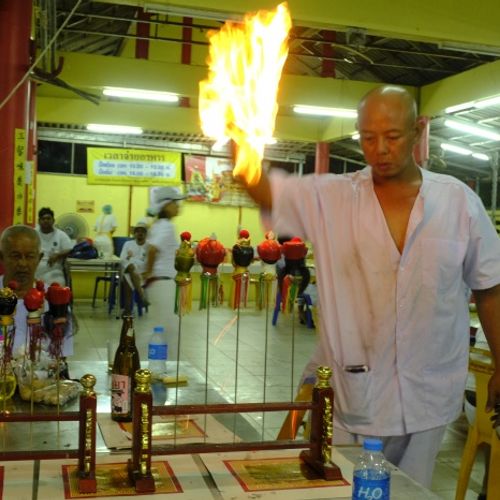Nine Emperor Gods Festival or Vegetarian Festival is a nine-days Taoist celebration beginning on the eve of the ninth lunar month of the Chinese calendar, celebrated primarily in Southeast Asian countries by the Taoist Chinese community. In Thailand this festival called Thetsakan Kin Che, means the " Vegetarian Festival ". It is celebrated throughout Thailand, with the festivities at the height in Phuket, where over that half of population is Peranakans { the peranakans are an ethnic group defined by their genealogical descent from the first waves of Southern Chinese settlers to maritime Southeast Asia, known as " Nanyang " }.
In 1825, when Phuket inhabited mostly by Chinese miners, the unnamed epidemic was spreading in Kathu town { first settlement of Chinese migrations on the island of Phuket } and caused several deaths. Among many patients, some of them were the members of an opera troupe from China. They also suddenly stricken by an epidemic when they were hired to perform in Phuket.
In hope of finding a cure, the Chinese opera troupe started and led the locals to abstain from eating meat and prayed to the Nine Emperor Gods for 9 days and 9 nights, as they used to practice during the ninth Chinese lunar month when they were in China.
Consequently, members of an opera troupe recovered their health afterwards and caused great curiosity to the locals. The practicing then widely accepted in the Chinese community on the island and passed down from generation to generation until the present day.
During the Vegetarian Festival, shops in Phuket display red and yellow flags to indicate they are serving appropriate vegan food for observant participants. Vegan food is prepared because it is considered the most pure. During the festival, food stall sell Thai and Chinese food made without animal products, also the dishes are prepared without the use of garlic, chili, onion, or strong spices. In addition to eating pure food, festival participants must keep their thoughts pure and wear white as a symbol of purity. Also to maintain purity devout festival participants abstain from sex, alcohol and stimulants during the festival.
The first event is called the Raising of the Lantern Pole, the pole is meant to invite the Nine Emperor Gods down to earth. Once the 10-metre-tall bamboo pole is erected, celebrants believe that Hindu god, Shiva, descends to bring spiritual power to the event.
According to an early-nineteenth-century interpretation of Chinese Taoism by a local community of Chinese immigrant miners, the Nine Emperor Gods descend from poles located in the shrine's yard and incarnate by using the bodies of the participants as shells for walking on Earth. The participants who prepare to volunteer their bodies to the gods are called the Ma Song.
Masong are the people who invite the spirit of gods to possess their bodies. Ma is the word for horse in Thai, and the name masong refers to how the spirit of the gods use the bodies of these people as a vehicle, as one rides a horse, { in English they are known as spirit mediums }. Only pure, unmarried men or women without families or their own can become masong { masong women are also called " Ah-mha " }. At the temple they undergo a series of rituals to protect them for the duration of the festival, during which flagellation and self-mutilation is practiced.
Masong wearing elaborate costumes who pierce their cheeks and tongues with all manner of amazing and incredible things. While the face is the most common area pierced, some also pierce their arms, back, chest and stomach. Team of people accompany the masong to keep their wounds clean and to help support the heavier piercings. Often, some member of that team carries a sacred sculture from the Taoist pantheon, sweets and amulets too, for the masong to give to devotees in the streets. It is believed that while are possessed the masong will not feel any pain. They can also be seen shaking their heads back and forth continually, and usually do not seem to " see " their surroundings.
The role of masong at the Phuket Vegetarian Festival is a unique and intriguing aspect of the event, and their participation in the spiritual rituals adds an extra layer of cultural significance and tradition to the festival, during which, masong are treated with reverence and respect, and seen as spiritual leaders and guides.
The masong men wear a characteristic and colorful Taoist apron, a flag and a whip made of vegetable fibers. The masong women also carry the flag and the whip, and wear elaborate and beautiful traditional Chinese dresses, and both go barefoot.
During the festival, masong can be seen participating in a variety of ritual, such as piercing and flagellation their bodies, walking on hot coals, or climbing ladders made of sharp blades. These rituals are seen as acts of spiritual devotion and self-mortification, and are believed to bring good fortune and blessings to the community.
In accordance with the traditions, many religious mediums will conduct ritualized mutilation upon themselves and one another while under a trance-like state. This is done without anesthesia, always inside or near the temples surrounded by other devotees with only iodine, petroleum jelly and surgical gloves as precautionary measures. Despite this scenario, many of the people performing the rituals are also the people who will care for many of the people in their recovery.
During the days of the festival the activity begins very early, between 4 and 5 in the morning, each day at a different Chinese shrine, sometimes two or more on the same day due to the large number of shrine that there are on the island of Phuket, and the time limit of 9 days. Masong women and men { separately } go into trance and perform the ritual prior to body piercings. Shortly after dawn, the processions get underway, with all their brotherhoods carrying their deities from the Taoist pantheon and surrounded by the explosion of hundreds of firecrackers. The masong that have already been pierced join the procession, the last masong leave incorporating little by little, and together they walk the streets of the city old town Phuket. For several hour, on this tour, the masong collect and deliver offerings and bless the people, with different types of rituals and many firecrackers. To end the tour at the old pier, where it is assumed that the first sailors arrived with Chinese migrants, and where a ceremony is performed and the piercings are removed, in some cases, the masong return by car to the shrine where they come from to remove the piercings. Once the piercings are removed, the masong, helped by others, performs a brief ritual to come out of the trance.
The order and sequence of the photographs: There are many images from this project that I want to show, including scenes of all the acts, rituals, and celebrations of the Phuket Vegetarian Festival. Thinking about what would be the ideal order to show this fascinating history, where culture and magic, religion and tradition, mysticism and beliefs are mixed. Where the human is mixed with the divine. Where humans become gods and gods become humans. Finally, I think the best way to show the images of the Phuket Vegetarian Festival is chronologically.
Images 1 to 25: October 14 Jui Tui Shrine.
Images 26 to 56: October 16 Naka Shrine.
Images 57 to 83: October 17 Sapam Shrine.
Images 84 to 123: October 18 Sam Kong Shrine.
Images 124 to 167: October 19 Tha Ruea Shrine.
Images 168 to 228: October 20 Bang Neow Shrine.
Images 229 to 325: October 21 Jui Tui Shrine.
Images 326 to 348: October 21 Bang Neow Shrine.
Images 349 to 381: October 22 Kathu Shrine.
Images 382 to 386: October 22 Bang Neow Shrine.
Images 387 to 426: October 23 Sui Boon Tong Shrine.
Images 427 to 433: October 23 Last Procession Phuket Town.
Images 434 to 448: October 24 Jui Tui Shrine.































































































































































































































































































































































































































































